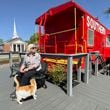DALLAS — By the time the sun came up in this stunned city Friday morning, a handful of bouquets, a couple of candles and several teddy bears had been left in front of police headquarters. A few hours into the day, a cruiser parked in front of the department was covered in blooms.
“We’re all affected,” said Senior Cpl. Marilyn Gates, her arm around her weeping colleague, Senior Cpl. Suzanne Torres.
Dallas Police Senior Cpl. Lorne Ahrens, Officers Michael Krol and Patrick Zamarripa, Sgt. Michael Smith and Dallas Area Rapid Transit Officer Brent Thompson were killed and several others were wounded when a gunman opened fire during a Thursday night march protesting recent police-involved shootings elsewhere.
Shooting suspect Micah Xavier Johnson, 25, was killed after police negotiations failed.
“It’s a tragic day for Dallas,” said Tom Cook, who with wife Sherri Cook came to the department with flowers on Friday morning. Tom Cook works downtown, near where the shootings took place.
“It’s too close,” Sherri Cook said.
Thursday's protest march through downtown Dallas mirrored similar events in cities nationwide, including Atlanta, as residents gathered to express outrage at this week's two fatal police shootings in Minnesota and Louisiana.
The Dallas march prior to the shootings has been widely described as peaceful and orderly, and photos of officers posing with marchers, all smiling, circulated on social media ahead of time Thursday evening. The scene quickly turned frenzied, then deadly, and grisly video clips filmed on attendees’ cellphones captured gunfire and in some cases, officers being hit.
At Baylor University Medical Center, the emergency room had been experiencing a normal volume of activity for a Friday night. Then came word of a massive shooting downtown, and doctors who weren’t even on duty at the time responded.
“It is absolutely horrific what we are doing to each other as a society,” said Dr. Ron Jensen, the head of emergency medicine at Baylor, a level-one trauma center where many of the wounded were taken. “It is a shame that a group, because of race, religion or lifestyle, feels that they are so disenfranchised that the only way they feel they can be heard is to harm officers. We all need to take a deep breath and learn to love one another.”
The scene was one of controlled chaos.
“We didn’t know if this was an isolated event or if this was another Orlando,” said Jensen. “But it is just about the work. You gotta stay focused on the work, because it is about getting the job done. We had no idea if we were getting five more or 40.”
By Friday afternoon, crowds gathered once again in downtown Dallas, this time for an interfaith prayer service. Police Chief David Brown received a thunderous round of applause before his remarks. Police work, he noted, isn’t often a job where you hear “thank you.”
The crowd responded as one: “THANK YOU!”
Brown spoke only briefly, saying he had to return to the investigation, but characterized the sniper attack as a “well-planned, well-thought-out, evil tragedy.”
He suggested that others could have had a role in Thursday’s ambush, saying “We won’t rest until we bring everyone involved to justice,” but the investigation has focused on Johnson. The U.S. Army veteran “had bomb-making materials, ballistic vests, rifles, ammunition, and a personal journal of combat tactics at his home,” The Associated Press reported. Johnson’s service included a tour of duty in Afghanistan with the Army Reserve, and his military occupational specialties were carpentry and masonry, the AP reported.
“He wanted to kill officers,” Brown said during an earlier news conference. “The suspect stated that he wanted to kill white people, especially white officers. He expressed anger for Black Lives Matter.”
The suspect described his motive during negotiations and said he acted alone and was not affiliated with any groups, Brown said.
A friend of Johnson’s told the AP that the slain suspect “wasn’t really political,” nor was he “a violent or rough dude.”
Israel Cooper said he played basketball with Johnson dozens of times near Johnson’s suburban Dallas house. He said the last time he saw Johnson was about a week ago and that Johnson was “cool” with a “good vibe.”
A bomb delivered via robot killed Johnson after negotiations failed. Both Brown and Dallas Mayor Mike Rawlings described the negotiations as extensive.
“We saw no other option than to use our bomb robot and place a device on its extension to detonate where the suspect was,” Brown said. “Other options would have exposed our officers to grave danger.”
“We did a lot of talking,” Rawlings said.
At a news conference late Friday afternoon, Rawlings and Texas Gov. Greg Abbott indicated that Johnson was the sole shooter, although the investigation into any possible conspirators continues.
“The suspect has received his justice,” Abbott said, adding that if others involved with the shooting are identified, “they will receive the justice they deserve.”
Abbott called for unity and gratitude for law enforcement following the attacks.
“We are so proud of our men and women who wear the uniform for their heroism in the face of remarkable danger,” he said. “Texas has its own brand of principles that elevate this state to true exceptionalism. One of those principles is respect and reverence for the men and women who wear the uniform.”
Clergy participating in Friday’s downtown interfaith service included Park Cities Baptist Church Pastor Jeff Warren and Bryan Carter, senior pastor of Concord Church.
“Pastor Carter and I recently returned from Charleston,” said Warren, referring to a joint pilgrimage to Emanuel African Methodist Episcopal Church, where nine people died in a June 2015 mass shooting. “We’ve got a lot of work to do but we’re standing here and we’re ready.”
Warren, who is white, and Carter, who is black, swapped pulpits on Palm Sunday 2015 to support racial unity. Warren urged the crowd to embrace that ideal.
“Find someone of another color. Find someone who is not like you today,” Warren said. “Tell them they’re loved by God, loved by you. Build bridges across racial lines.”
Carter echoed his friend’s sentiments.
“We’re here today because we share a common pain,” he said. “Our hearts are heavy with grief. But we refuse to hate each other. We refuse to point fingers at one another. Together we gather together to commit to pray our way to healing and restoration. We also commit to work together. We believe it takes all of us to bring the healing we all so desperately need.”
After the service, which featured remarks from faith and civic leaders, musical tributes and prayers, many of those in attendance stood in line to offer their personal thanks to men and women in uniform. Soon, everyone started hugging.
“I felt like what I needed right now was togetherness,” said Katherine Van Dyke, who attended with a friend. “I hope this encourages everyone to choose love.”
Senior Cpls. Monica Cordova and Debra Webb were among the officers who started out directing traffic and wound up in a receiving line of sorts, as people waited patiently to give them hugs and handshakes. A few people lifted up their babies to join the embrace.
“It’s overwhelming,” Cordova said. “We were overwhelmed with grief. Now we’re overwhelmed with gratitude.”
About the Author






